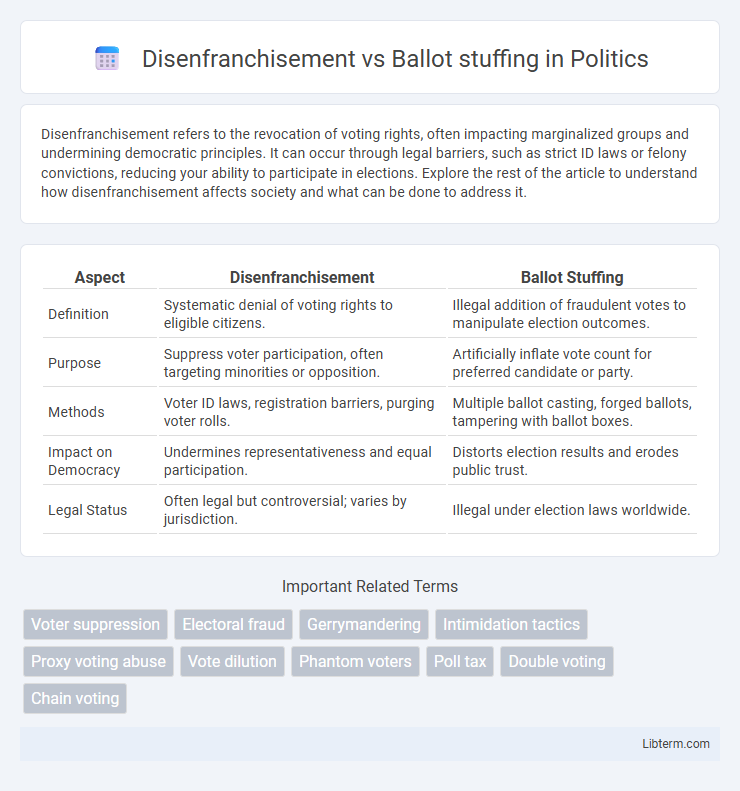Disenfranchisement refers to the revocation of voting rights, often impacting marginalized groups and undermining democratic principles. It can occur through legal barriers, such as strict ID laws or felony convictions, reducing your ability to participate in elections. Explore the rest of the article to understand how disenfranchisement affects society and what can be done to address it.
Table of Comparison
| Aspect | Disenfranchisement | Ballot Stuffing |
|---|---|---|
| Definition | Systematic denial of voting rights to eligible citizens. | Illegal addition of fraudulent votes to manipulate election outcomes. |
| Purpose | Suppress voter participation, often targeting minorities or opposition. | Artificially inflate vote count for preferred candidate or party. |
| Methods | Voter ID laws, registration barriers, purging voter rolls. | Multiple ballot casting, forged ballots, tampering with ballot boxes. |
| Impact on Democracy | Undermines representativeness and equal participation. | Distorts election results and erodes public trust. |
| Legal Status | Often legal but controversial; varies by jurisdiction. | Illegal under election laws worldwide. |
Understanding Disenfranchisement: Definition and Forms
Disenfranchisement refers to the systematic denial of voting rights to specific groups, often based on race, gender, or socioeconomic status, effectively excluding them from participating in democratic processes. It manifests in various forms, including voter ID laws, felony disenfranchisement, and gerrymandering that dilutes minority voting power. Understanding these mechanisms is crucial for addressing electoral inequalities and safeguarding civil rights.
What Is Ballot Stuffing? An Overview
Ballot stuffing refers to the illegal practice of submitting multiple ballots or fraudulent votes to manipulate election outcomes, undermining the integrity of democratic processes. It often occurs during elections where monitoring is weak, enabling perpetrators to artificially inflate vote counts in favor of a particular candidate or party. Unlike disenfranchisement, which involves depriving eligible voters of their voting rights, ballot stuffing actively distorts election results through vote tampering.
Historical Context of Disenfranchisement
Disenfranchisement historically targeted marginalized groups through laws such as poll taxes, literacy tests, and grandfather clauses, primarily in the post-Reconstruction American South to suppress African American voting rights. This systematic exclusion distorted electoral representation and perpetuated racial inequalities for decades. Ballot stuffing, by contrast, involves fraudulent vote counting to manipulate election outcomes but lacks the structural, legally codified oppression seen in disenfranchisement.
Famous Cases of Ballot Stuffing in Election History
Famous cases of ballot stuffing in election history include the 1946 Italian general election, where widespread fraud was reported to influence the outcomes favoring the Christian Democrats, and the 1986 Philippine presidential election, marked by massive ballot stuffing that led to the People Power Revolution and the eventual ousting of Ferdinand Marcos. The 1876 U.S. presidential election also featured accusations of ballot stuffing, particularly in Southern states, contributing to one of the most disputed elections in American history. These incidents illustrate the severe impact of ballot stuffing on electoral integrity, contrasting sharply with disenfranchisement, which involves denying eligible voters their right to participate.
Key Differences Between Disenfranchisement and Ballot Stuffing
Disenfranchisement involves denying eligible voters the right to vote through legal, administrative, or social barriers, significantly impacting voter participation and representation. Ballot stuffing refers to the fraudulent practice of casting multiple votes or inserting illegitimate ballots to manipulate election outcomes. The key difference lies in disenfranchisement suppressing legitimate votes, whereas ballot stuffing inflates vote counts illegally to skew election results.
The Impact on Democratic Processes
Disenfranchisement suppresses voter participation by systematically excluding certain groups, undermining the legitimacy of electoral outcomes and weakening democratic representation. Ballot stuffing artificially inflates vote counts, distorts election results, and erodes public trust in the fairness of democratic processes. Both practices disrupt the integrity of elections, leading to decreased voter confidence and potentially destabilizing governance structures.
Detecting and Preventing Electoral Fraud
Detecting electoral fraud requires distinguishing disenfranchisement--where eligible voters are unfairly prevented from voting--from ballot stuffing, which involves submitting fraudulent votes to manipulate outcomes. Advanced voter verification systems, including biometric authentication and blockchain-based voting records, help prevent disenfranchisement by ensuring only registered voters participate. Simultaneously, real-time ballot tracking and audit trails enhance detection of ballot stuffing by identifying irregular voting patterns and unauthorized ballot submissions.
Legal Consequences and Accountability
Disenfranchisement, often resulting from laws that restrict voter eligibility or access, can lead to legal challenges seeking to restore voting rights and hold governments accountable for violations of constitutional protections. Ballot stuffing, a form of electoral fraud involving the illegal addition of votes, triggers criminal prosecutions and strict penalties to deter manipulation of election outcomes. Both offenses undermine democratic processes, with courts and election authorities enforcing legal mechanisms to preserve electoral integrity and ensure accountability.
Global Perspectives: Case Studies from Around the World
Disenfranchisement and ballot stuffing represent contrasting electoral malpractices impacting democratic integrity worldwide. In Venezuela, disenfranchisement of opposition voters has undermined electoral competitiveness, while in Kenya's 2007 elections, extensive ballot stuffing fueled post-election violence. These case studies underscore the global challenge of safeguarding electoral processes against both voter suppression and fraudulent vote inflation.
Safeguarding Election Integrity: Solutions and Reforms
Disenfranchisement and ballot stuffing represent critical threats to election integrity, requiring distinct yet complementary safeguards. Implementing robust voter identification systems, transparent vote counting processes, and active monitoring by independent observers can significantly reduce instances of ballot stuffing. Expanding voter access through reforms such as automatic voter registration and protecting voting rights addresses disenfranchisement by ensuring that all eligible citizens can participate freely and fairly in elections.
Disenfranchisement Infographic

 libterm.com
libterm.com